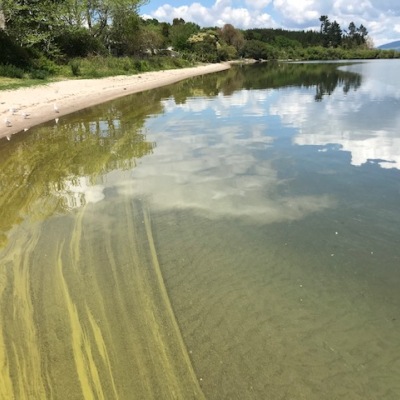
23 October 2020
The combination of the recent warmer temperatures and an out of action dosing plant has likely contributed to a potentially toxic algae bloom in Lake Rotorua. Sightings near Holden’s Bay, the Ohau channel, and Awahou river have confirmed the presence of this bloom also referred to as cyanobacteria.
Bay of Plenty Regional Council Rotorua Catchments Manager Helen Creagh said people should take care if they are fishing for trout near the affected locations and follow advice from Toi Te Ora Public Health around whether it is safe to swim in the lake.
“At this point, we would advise the community to avoid fishing for trout near the affected locations,” Ms Creagh said.
Cyanobacteria (also known as blue-green algae) are a natural occurrence, but can form blooms in response to warmer temperatures and excess available nutrients. Some species produce toxins as they die, which may cause illness in humans and pets who drink or swim in affected water. Symptoms range from nausea and diarrhoea, to more serious conditions such as liver damage.
Bay of Plenty Regional Council manage two alum dosing plants, located near the Utuhina and Puarenga streams. Maintenance work is currently taking place on the Puarenga plant. So far, the dosing plants have been successful at improving water quality in Lake Rotorua.
Ms Creagh said the plant will be operational before Christmas and dosing will be increased in response to this type of bloom however until the plant is operational more blooms are likely.
Alum dosing refers to treating incoming streams with alum which helps reduce the impacts of phosphorus in certain lakes. The continual low dose of alum binds phosphorus in the incoming streams so when the streams reach the lake, plants (like algae) cannot use the phosphorus to grow.
Ms Creagh says it is likely that with climate change predictions of higher ambient temperatures this type of bloom could occur regularly.
“We will continue to monitor the situation and any updates will be available on the Rotorua Te Arawa Lakes Programme's website, as well as Toi te Ora Public Health,” Ms Creah said.
Alum dosing in the streams is just one method under the Rotorua Te Arawa Lakes Programme that aims to improve water quality. For more information, visit www.rotorualakes.co.nz.